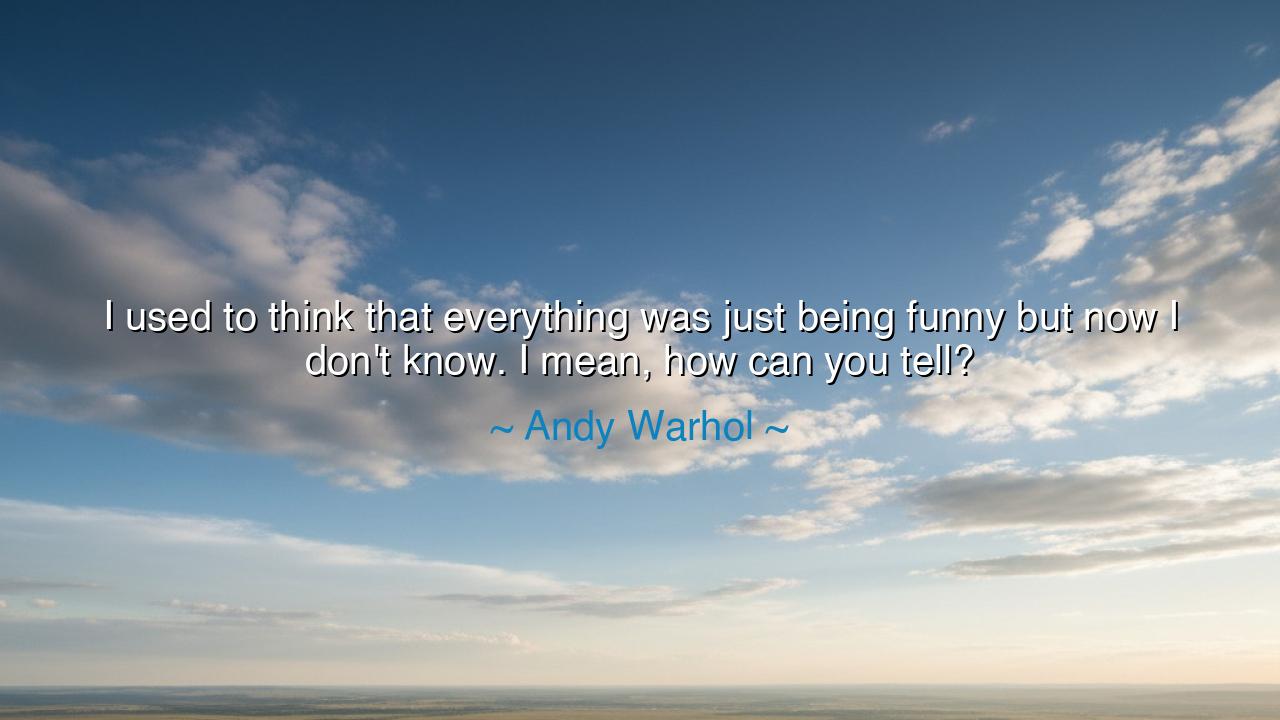
I used to think that everything was just being funny but now I
I used to think that everything was just being funny but now I don't know. I mean, how can you tell?






In the words of Andy Warhol, “I used to think that everything was just being funny but now I don’t know. I mean, how can you tell?” In this cryptic confession, the artist who once turned the trivial into treasure and the mundane into miracle reveals the trembling uncertainty beneath his cool, ironic surface. It is a moment of spiritual candor — the admission of a man who has stared so long into the mirror of modernity that he can no longer tell whether the reflection smiles or mocks. Warhol’s words speak not only of humor, but of the blur between irony and sincerity, between play and pain, between the performance of life and life itself.
Warhol was the high priest of the Pop Art movement, the painter of soup cans and movie stars, the one who transformed the symbols of consumerism into icons of philosophy. He lived in an age when fame became religion and the image replaced the soul. To him, everything was “funny” — the absurdity of glamour, the spectacle of desire, the emptiness behind the smile of celebrity. Yet as he gazed deeper into the world he both celebrated and parodied, he began to sense a hollowness. What began as laughter became question, what was once parody became prophecy. His question — “How can you tell?” — is the cry of one who realizes that irony, once a shield, can become a cage.
The ancients knew this feeling well. Diogenes, the cynic philosopher, mocked the hypocrisy of Athens by living in poverty and laughing at its false virtues. He barked like a dog at the proud and the powerful, believing that humor could reveal truth. Yet even Diogenes, in his solitude, must have wondered whether his laughter freed him or isolated him. So too with Warhol — his art laughed at the world, but in time, the laughter echoed back. Was he mocking society, or was society mocking him? When everything becomes performance, when every smile is a mask, even the clown forgets where his true face lies.
Warhol’s quote, in its quiet despair, reveals the danger of detachment. To laugh at everything is to protect oneself from sorrow — but it also means never feeling fully alive. Humor, in its highest form, is wisdom; it allows us to see absurdity without being crushed by it. Yet when laughter becomes our only lens, meaning slips away. Warhol’s words are the confession of an artist who saw the world as spectacle for too long, until the spectacle swallowed truth. “How can you tell?” he asks — and indeed, when irony becomes constant, sincerity becomes invisible.
Consider the story of Nero, emperor of Rome, who performed on stage as the city burned. To him, tragedy was theater, and theater was life. He blurred the line between reality and performance until all meaning dissolved into artifice. Warhol, centuries later, stood in that same space — not as tyrant, but as mirror-holder. His doubt was not madness, but revelation: that modernity itself had become a play with no script, a world where everyone performs but no one believes. This was his genius and his torment — to laugh at a world that no longer knows when to laugh.
And yet, there is compassion in Warhol’s uncertainty. For in his question lies the recognition that beneath all irony, the human heart still longs for truth. The artist’s confusion becomes a call to awaken — to look beyond sarcasm and self-defense, to rediscover what is real. Warhol’s art, with its repetition of faces and products, invites us to ask: What is behind the image? Is there still a soul in the machinery of modern life? His question is the eternal artist’s struggle — to find sincerity in a world that rewards performance.
The lesson, then, is this: do not let irony become armor against meaning. Humor is a sacred gift, but when it replaces honesty, the spirit starves. Laugh, yes, but also feel. Question, but also believe. In a time when the world itself feels like performance — when we curate our lives into endless portraits of perfection — we must remember Warhol’s uncertainty as wisdom: “How can you tell?” Ask it often. Let it remind you to seek the line between truth and illusion.
Practical teaching: Each day, when you find yourself laughing at the world, ask whether your laughter springs from joy or defense. When you speak ironically, ask whether you are protecting your heart or hiding it. Create, express, and live with authentic intention, not just clever reflection. Be willing to mean what you say, even when the world does not. For as Andy Warhol discovered, to see everything as “funny” is to risk losing the sacred seriousness of being alive — and the truest art, the truest life, comes from those who can still tell the difference.






AAdministratorAdministrator
Welcome, honored guests. Please leave a comment, we will respond soon